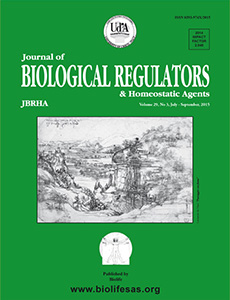JOURNAL OF BIOLOGICAL REGULATORS & HOMEOSTATIC AGENTS
L. SCAPOLI1, A. GIRARDI1, A. PALMIERI1, M. MARTINELLI1, F. CURA1, D. LAURITANO2, F. PEZZETTI1 and F.CARINCI3
1Department of Experimental, Diagnostic and Specialty Medicine, University di Bologna, Bologna,
Italy;
2Department of Translational medicine and surgery, Neuroscience Centre of Milan, University
of Milano Bicocca, Monza, Italy;
3Department of Morphology, Surgery and Experimental Medicine, University of Ferrara, Ferrara, Italy
Gingivitis and periodontitis are the two main periodontal diseases. Both are characterized by inflammation of the tissues surrounding the teeth but while tissue damages observed in gingivitis are mild and reversible, destruction caused by periodontitis is deeper and irreversible. Periodontal diseases and levels of degeneration of tissues surrounding teeth depend on several interacting endogenous and exogenous factors. Polymorphisms of genes encoding molecules that modulate the immune response and tissue homeostasis are the main causes of individual susceptibility to periodontal diseases. The aim of this study was to investigate IL6, IL10 and VDR gene polymorphisms in a large number of subjects affected by either gingivitis or chronic periodontitis. The sample included 750 Italian patients. We found that the rs1800795 SNP located in the IL6 gene promoter was strongly associated with the occurrence of both gingivitis and periodontitis. Indeed, homozygous individuals with variant allele appeared less-susceptible to both gingivitis OR=0.47 (95% C.I. 0.27-0.82) and periodontitis OR=0.36 (95% C.I.
0.21-0.64). No evidence of association between periodontal diseases and IL10 or VDR polymorphisms was obtained. This data confirmed the role of IL6 in susceptibility to periodontitis among the Italian population. The evidence that IL6 polymorphisms are also involved in gingivitis has implications in periodontal disease pathogenesis and reduces the appeal of IL6 as a periodontitis biomarker.

